Snub polyhedron
| Polyhedron | |
| Class | Number and properties |
|---|---|
| Platonic solids |
(5, convex, regular) |
| Archimedean solids |
(13, convex, uniform) |
| Kepler–Poinsot polyhedra |
(4, regular, non-convex) |
| Uniform polyhedra |
(75, uniform) |
| Prismatoid: prisms, antiprisms etc. |
(4 infinite uniform classes) |
| Polyhedra tilings | (11 regular, in the plane) |
| Quasi-regular polyhedra |
(8) |
| Johnson solids | (92, convex, non-uniform) |
| Pyramids and Bipyramids | (infinite) |
| Stellations | Stellations |
| Polyhedral compounds | (5 regular) |
| Deltahedra | (Deltahedra, equilateral triangle faces) |
| Snub polyhedra |
(12 uniform, not mirror image) |
| Zonohedron | (Zonohedra, faces have 180°symmetry) |
| Dual polyhedron | |
| Self-dual polyhedron | (infinite) |
| Catalan solid | (13, Archimedean dual) |
A snub polyhedron is a polyhedron obtained by alternating a corresponding omnitruncated or truncated polyhedron, depending on the definition. Some but not all authors include antiprisms as snub polyhedra, as they obtained by this construction from a degenerate "polyhedron" with only two faces.
Chiral snub polyhedra do not always have reflection symmetry and hence sometimes have two enantiomorphous forms which are reflections of each other. Their symmetry groups are all point groups.
For example, the snub cube:
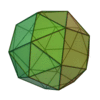 |
 |
Snub polyhedra have Wythoff symbol | p q r and by extension, vertex configuration 3.p.3.q.3.r. Retrosnub polyhedra (a subset of the snub polyhedron, containing the great icosahedron, small retrosnub icosicosidodecahedron, and great retrosnub icosidodecahedron) still have this form of Wythoff symbol, but their vertex configurations are instead (3.−p.3.−q.3.−r)/2.
Among the snub polyhedra that cannot be otherwise generated, only the pentagonal antiprism, pentagrammic antiprism, pentagrammic crossed-antiprism, small snub icosicosidodecahedron and small retrosnub icosicosidodecahedron are known to occur in any non-prismatic uniform 4-polytope. The tetrahedron, octahedron, icosahedron, and great icosahedron appear commonly in non-prismatic uniform 4-polytopes, but not in their snub constructions. Every snub polyhedron however can appear in the polyhedral prism based on them.
List of snub polyhedra
Uniform
There are 12 uniform snub polyhedra, not including the antiprisms, the icosahedron as a snub tetrahedron, the great icosahedron as a retrosnub tetrahedron and the great disnub dirhombidodecahedron, also known as Skilling's figure.
When the Schwarz triangle of the snub polyhedron is isosceles, the snub polyhedron is not chiral. This is the case for the antiprisms, the icosahedron, great icosahedron, small snub icosicosidodecahedron, and small retrosnub icosicosidodecahedron.
In the pictures of the snub derivation (showing a distorted snub polyhedron, topologically identical to the uniform version, arrived at from geometrically alternating the parent uniform omnitruncated polyhedron) where green is not present, the faces derived from alternation are coloured red and yellow, while the snub triangles are blue. Where green is present (only for the snub icosidodecadodecahedron and great snub dodecicosidodecahedron), the faces derived from alternation are red, yellow, and blue, while the snub triangles are green.
| Snub polyhedron | Image | Original omnitruncated polyhedron | Image | Snub derivation | Symmetry group | Wythoff symbol Vertex description |
|---|---|---|---|---|---|---|
| Icosahedron (snub tetrahedron) |  |
Truncated octahedron |  |
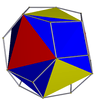 |
Ih (Th) | | 3 3 2 3.3.3.3.3 |
| Great icosahedron (retrosnub tetrahedron) |  |
Truncated octahedron |  |
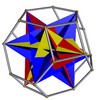 |
Ih (Th) | | 2 3/2 3/2 (3.3.3.3.3)/2 |
| Snub cube or snub cuboctahedron |
 |
Truncated cuboctahedron | 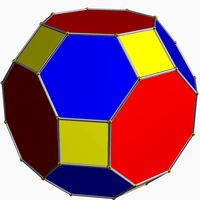 |
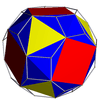 |
O | | 4 3 2 3.3.3.3.4 |
| Snub dodecahedron or snub icosidodecahedron |
 |
Truncated icosidodecahedron | 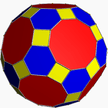 |
 |
I | | 5 3 2 3.3.3.3.5 |
| Small snub icosicosidodecahedron |  |
Doubly covered truncated icosahedron | 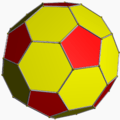 |
 |
Ih | | 3 3 5/2 3.3.3.3.3.5/2 |
| Snub dodecadodecahedron |  |
Small rhombidodecahedron with extra 12{10/2} faces | 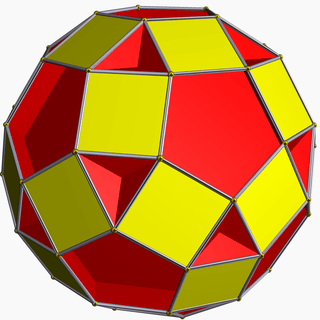 |
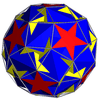 |
I | | 5 5/2 2 3.3.5/2.3.5 |
| Snub icosidodecadodecahedron |  |
Icositruncated dodecadodecahedron | 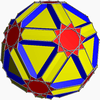 |
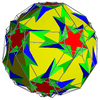 |
I | | 5 3 5/3 3.5/3.3.3.3.5 |
| Great snub icosidodecahedron | 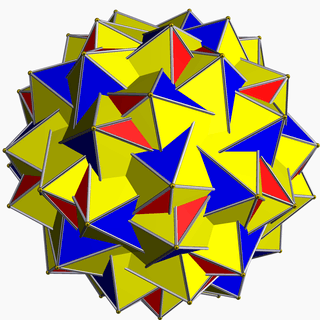 |
Rhombicosahedron with extra 12{10/2} faces |  |
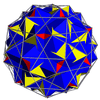 |
I | | 3 5/2 2 3.3.5/2.3.3 |
| Inverted snub dodecadodecahedron |  |
Truncated dodecadodecahedron |  |
 |
I | | 5 2 5/3 3.5/3.3.3.3.5 |
| Great snub dodecicosidodecahedron | 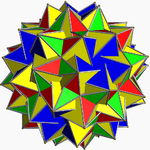 |
Great dodecicosahedron with extra 12{10/2} faces |  |
no image yet | I | | 3 5/2 5/3 3.5/3.3.5/2.3.3 |
| Great inverted snub icosidodecahedron | 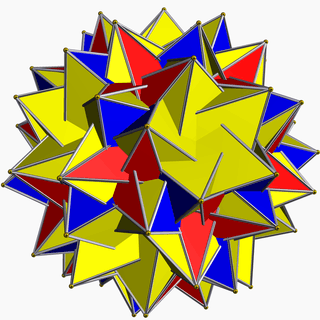 |
Great truncated icosidodecahedron |  |
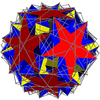 |
I | | 3 2 5/3 3.5/3.3.3.3 |
| Small retrosnub icosicosidodecahedron | 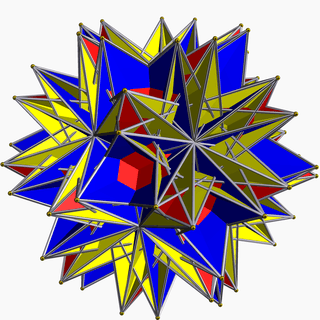 |
Doubly covered truncated icosahedron |  |
no image yet | Ih | | 5/2 3/2 3/2 (3.3.3.3.3.5/2)/2 |
| Great retrosnub icosidodecahedron | 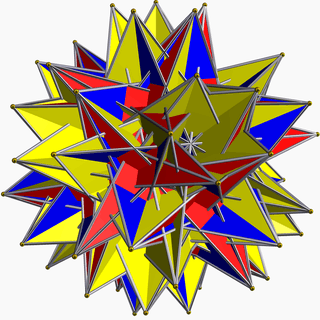 |
Great rhombidodecahedron with extra 20{6/2} faces | 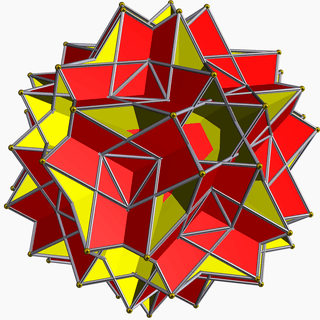 |
no image yet | I | | 2 5/3 3/2 (3.3.3.5/2.3)/2 |
| Great dirhombicosidodecahedron | 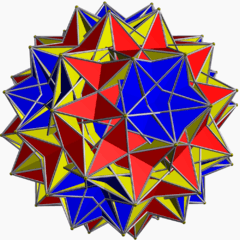 |
— | — | — | Ih | | 3/2 5/3 3 5/2 (4.3/2.4.5/3.4.3.4.5/2)/2 |
| Great disnub dirhombidodecahedron |  |
— | — | — | Ih | | (3/2) 5/3 (3) 5/2 (3/2.3/2.3/2.4.5/3.4.3.3.3.4.5/2.4)/2 |
Notes:
- The icosahedron, snub cube and snub dodecahedron are the only three convex ones. They are obtained by snubification of the truncated octahedron, truncated cuboctahedron and the truncated icosidodecahedron - the three convex truncated quasiregular polyhedra.
- The only snub polyhedron with the chiral octahedral group of symmetries is the snub cube.
- Only the icosahedron and the great icosahedron are also regular polyhedra. They are also deltahedra.
- Only the icosahedron, great icosahedron, small snub icosicosidodecahedron, small retrosnub icosicosidodecahedron, great dirhombicosidodecahedron, and great disnub dirhombidodecahedron also have reflective symmetries.
There is also the infinite set of antiprisms. They are formed from prisms, which are truncated hosohedra, degenerate regular polyhedra. Those up to hexagonal are listed below. In the pictures showing the snub derivation, the faces derived from alternation (of the prism bases) are coloured red, and the snub triangles are coloured yellow.
| Snub polyhedron | Image | Original omnitruncated polyhedron | Image | Snub derivation | Symmetry group | Wythoff symbol Vertex description |
|---|---|---|---|---|---|---|
| Tetrahedron |  |
Cube | 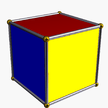 |
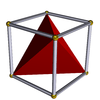 |
Td (D2d) | | 2 2 2 3.3.3 |
| Octahedron |  |
Hexagonal prism | 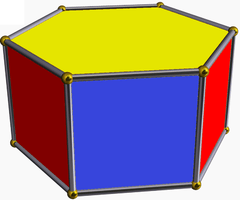 |
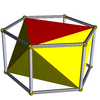 |
Oh (D3d) | | 3 2 2 3.3.3.3 |
| Square antiprism |  |
Octagonal prism |  |
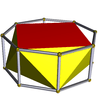 |
D4d | | 4 2 2 3.4.3.3 |
| Pentagonal antiprism |  |
Decagonal prism |  |
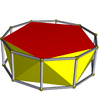 |
D5d | | 5 2 2 3.5.3.3 |
| Pentagrammic antiprism |  |
Doubly covered pentagonal prism |  |
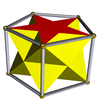 |
D5h | | 5/2 2 2 3.5/2.3.3 |
| Pentagrammic crossed-antiprism |  |
Decagrammic prism | 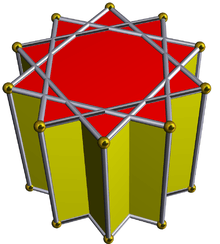 |
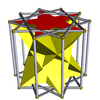 |
D5d | | 2 2 5/3 3.5/3.3.3 |
| Hexagonal antiprism |  |
Dodecagonal prism |  |
 |
D6d | | 6 2 2 3.6.3.3 |
Notes:
- Two of these polyhedra may be constructed from the first two snub polyhedra in the list starting with the icosahedron: the pentagonal antiprism is a parabidiminished icosahedron and a pentagrammic crossed-antiprism is a parabidiminished great icosahedron, also known as a parabireplenished great icosahedron.
Non-uniform
Two Johnson solids are snub polyhedra: the snub disphenoid and the snub square antiprism. Neither is chiral.
| Snub polyhedron | Image | Original polyhedron | Image | Symmetry group |
|---|---|---|---|---|
| Snub disphenoid |  |
Disphenoid | 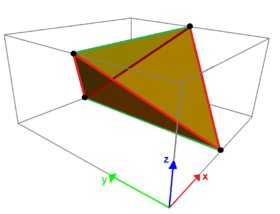 |
D2d |
| Snub square antiprism | 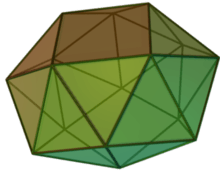 |
Square antiprism |  |
D4d |
References
- Coxeter, Harold Scott MacDonald; Longuet-Higgins, M. S.; Miller, J. C. P. (1954), "Uniform polyhedra", Philosophical Transactions of the Royal Society of London. Series A. Mathematical and Physical Sciences, 246: 401–450, doi:10.1098/rsta.1954.0003, ISSN 0080-4614, JSTOR 91532, MR 0062446
- Wenninger, Magnus (1974). Polyhedron Models. Cambridge University Press. ISBN 0-521-09859-9.
- Skilling, J. (1975), "The complete set of uniform polyhedra", Philosophical Transactions of the Royal Society of London. Series A. Mathematical and Physical Sciences, 278: 111–135, doi:10.1098/rsta.1975.0022, ISSN 0080-4614, JSTOR 74475, MR 0365333
- Mäder, R. E. Uniform Polyhedra. Mathematica J. 3, 48-57, 1993.
| Seed | Truncation | Rectification | Bitruncation | Dual | Expansion | Omnitruncation | Alternations | ||
|---|---|---|---|---|---|---|---|---|---|
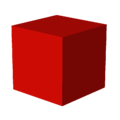 |
 |
 |
 |
 |
 |
 |
 |
 |
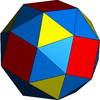 |
| t0{p,q} {p,q} |
t01{p,q} t{p,q} |
t1{p,q} r{p,q} |
t12{p,q} 2t{p,q} |
t2{p,q} 2r{p,q} |
t02{p,q} rr{p,q} |
t012{p,q} tr{p,q} |
ht0{p,q} h{q,p} |
ht12{p,q} s{q,p} |
ht012{p,q} sr{p,q} |